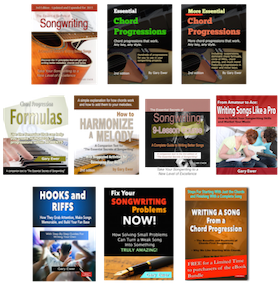If you’ve written a hook, and most if not all of the following aren’t true, you’ve not really written an effective one:
- It’s got a short and easy-to-remember melody.
- It incorporates a catchy rhythm.
- It uses a relatively simple, short chord progression.
- It usually appears, disappears, and reappears throughout a song.
- It’s fun to sing.
When songwriters use the word hook, they might be using it synonymously with chorus. For me, I like to narrow the focus to exactly what is acting as a hook, to that thing that’s actually doing the job of pulling listeners in. And it’s usually something short, catchy, easy to remember, and fun to sing.
 There’s more to a hook than you probably ever thought. Discover it all here: “Hooks and Riffs: How They Grab Attention, Make Songs Memorable, and Build Your Fan Base“. It’s part of “The Essential Secrets of Songwriting” eBook bundle package. Buy today and get “creative Chord Progression” free.
There’s more to a hook than you probably ever thought. Discover it all here: “Hooks and Riffs: How They Grab Attention, Make Songs Memorable, and Build Your Fan Base“. It’s part of “The Essential Secrets of Songwriting” eBook bundle package. Buy today and get “creative Chord Progression” free.
For example, you might say that the chorus of Lennon & McCartney’s “She Loves You” is a great hook, and of course it is. But as a songwriter, you’ll benefit from putting a magnifying glass on that chorus to find out exactly what is so hooky about it. Without doubt, the “yeah, yeah, yeah” does most of the work here. It’s short, catchy, easy to remember, uses a simple rhythmic syncopation, a simple chord progression, and it’s fun to sing.
One of the reasons I like to focus in on exactly what the hooky part is stems from the fact that not every song will use an obvious hook. Many songs make better use of motifs than they do of hooks. Like a hook, a motif is a short musical fragment — but not usually “catchy” in the same way. A song like Pink’s “Family Portrait” (Pink, Scott Storch) might be one that demonstrates this. The short cells that go together to make the melodies all have a similar shape:

That melodic shape is not something that’s obvious, and in fact, that’s a normal characteristic of motifs: they usually do their work in the background. As you listen to the rest of the song, you’ll notice other lines of melody that aren’t the same, but are somewhat similar. That’s the motif at work. Listeners won’t immediately notice (or perhaps ever notice) that many of the melodic shapes in the song are similar. But the similarity, noticed or not, helps to glue the song together in a very important way.
All of this is to say that it is quite possible to write a song that doesn’t have a powerful hook, as long as there are structural elements within the song that share similar traits. These similar traits, based on musical ideas — motifs — give the music an important sense of cohesion in much the same way that using the same kind of shingle on your house, or similar wall colours inside, gives it cohesion.
Even songs that use a strong hook need the structural strength that comes from using a motif. How do you make sure that your songs have this kind of motivic power? With each song you finish, you should notice:
- The rhythms of the backing instruments are borrowed from, or developed from, rhythms found in the melody or other melodic instruments.
- Melodic shapes played by the backing instruments can be found in other instrumental or vocal parts within the song. (Compare the instrumental and vocal lines in John Denver’s “Fly Away” – a brilliant example of this.)
- Melodies in one part of a song are either similarly constructed, or perhaps purposefully opposite to the kinds of melodies found in another part. For example, your verse might use upward-moving melodic cells, and your chorus might use downward-moving ones. That kind of opposite treatment of a melody is a motif at work.
While it’s true that for most hit songs in the pop genres hooks are a regular feature, it’s quite possible to write a song that doesn’t present an obvious hook. But for those songs where the hook is subdued or almost non-existent, the cohesion that comes from using motifs is crucial.
If you want to know more about motifs, try this article: “How Songs Benefit When You Use Musical Motifs.”
 Written by Gary Ewer. Follow on Twitter.
Written by Gary Ewer. Follow on Twitter.
 “The Essential Secrets of Songwriting” eBook Bundle looks at songwriting from every angle, and has been used by thousands of songwriters. How to use chords, write melodies, and craft winning lyrics.
“The Essential Secrets of Songwriting” eBook Bundle looks at songwriting from every angle, and has been used by thousands of songwriters. How to use chords, write melodies, and craft winning lyrics.











Pingback: The Musical Cohesion That Comes From Motifs - The Hit Songwriting Formula | The Hit Songwriting Formula